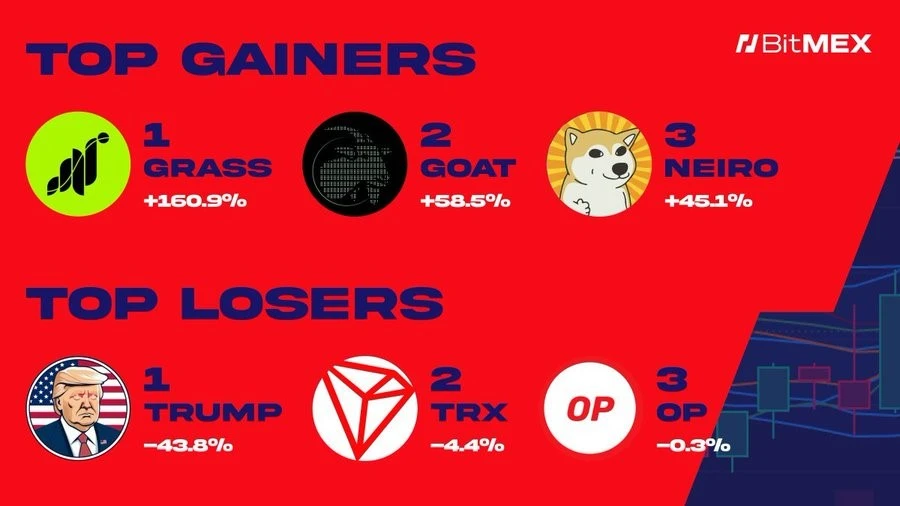Original author: BitMEX
Too long to read
With Trump winning the presidential election, cryptocurrencies are having their best time in years, with Bitcoin hitting new all-time highs and stabilizing in the $75,000 range.
This week we saw gains across the board. DeFi tokens were the main beneficiary as traders viewed Trump’s world free finance project and his presidency as a big win for the DeFi industry. The SEC is likely to ease up on its lawsuits against DeFi and utility tokens, which is especially positive for DeFi.
In our trading alpha section, we will analyze $GRASS, a project that tripled 8 days after TGE. What caused their unexpected surge?
Data Overview

High-quality currency
$GRASS (+160.9%): Grass TGE soars against all expectations, becoming the most successful token launch of 2024
$GOAT (+58.5%): Goatse remains strong, hitting new all-time highs, proving AI meme coins are here to stay
$Neiro (+45.1%): With DOGE being the biggest gainer of the week, traders are quickly turning to $Neiro — the successor to $DOGE
Poor quality currency
$TRUMP (-43.8%): Trump won the election, and $TRUMP became a good news event
$TRX (-4.4%): After outperforming in recent weeks, $TRX is seeing a pullback
$OP (-0.3%): Not really a bad coin, but $OP failed to rise in this round of surge
News Flash
Macro
ETH ETF weekly inflows: +$68.8 million ( source )
BTC ETF weekly inflows: +$1.37 billion ( source )
The Federal Reserve cut interest rates by 25 basis points as expected ( source )
Donald Trump elected 47th President of the United States ( Source )
Powell: No plan to reduce inflation to below 2%, will not resign because of Trump ( source )
Bitcoin surged 12% against gold on Wednesday, its biggest one-day gain since February 28, 2022
UK House of Lords echoes support for Digital Asset Property Bill ( source )
project
Jito Labs monthly fee revenue in October reached $78.9 million, double the previous record set in May ( source )
Just four entities accounted for nearly all of the votes in favor of MakerDAO’s name change to Sky ( source )
Swell Network has opened SWELL token airdrops
France will ban Polymarket ( source )
SushiSwap launches Vesting Launch, a linearly released memecoin issuance platform ( source )
Avalanche Foundation buys back $52 million worth of AVAX tokens from Do Kwon’s defunct “Luna Foundation Guard” ( Source )
Trading Insights
NOTE: The following should not be considered financial advice. This is a compilation of market news and we always encourage you to do your own research (DYOR) before executing any trades. The following is not meant to guarantee any returns and BitMEX cannot be held responsible if your trades do not perform as expected.
3x increase in 8 days - What is $GRASS?
What is Grass?
Simply put, Grass sells users idle network bandwidth. Before Grass, users could only share bandwidth unconditionally and could not cash it out. This is expected to completely change the landscape of Internet infrastructure.
Grass core selling point is its decentralized network architecture. Users can provide idle bandwidth in exchange for network ownership (grass tokens). Currently, the Grass network can process more than 100 TB of data per day, with nodes in 190 countries and a total of more than 2.5 million.
Grass’s Moat
Grass unique advantages and fundamentals are quite impressive:
Able to process 80 TB of data per day - this is enough to train two GPT-3/3.5 (GPT-3/3.5 training requires 45 TB)
Nearly 1 billion minutes of multimodal data (video, images) have been captured, attracting many companies to spend money
2.5 million daily active users, explosive growth within a year
Maintains a massive network of 2 million nodes
It has been used by AI labs and has attracted the attention of many Fortune 500 companies.
Plans to enter the mobile market and cooperate with Xbox and Roku TV
CEO says potential demand for the Internet is already in the nine figures
These factors give Grass the potential to become a dark horse in the Internet Service Provider (ISP) industry and the broader crypto/AI ecosystem.
From a token economics perspective, Grass model of rewarding bandwidth contributors with ownership shares creates an interesting supply and demand dynamic. The project allows companies to pay users directly for bandwidth use, opening up a significant revenue channel for $GRASS. This may attract decentralized AI projects (dApps) and even traditional technology companies to seek cooperation, driving up demand for Grass tokens.
However, the regulatory risks brought by this disruptive model cannot be ignored. The project may face strict scrutiny from telecom regulators and existing ISPs, which may affect its growth trajectory and, in turn, the value of the token. In addition, although the growth and user data look beautiful, in the cryptocurrency field, DAU (daily active users) data can sometimes be exaggerated or misleading, so be vigilant.
Summarize
Grass has come up with an innovative way to monetize idle network bandwidth, and its growth and user adoption rates are quite impressive. The project can process massive amounts of data every day, and with a large network of nodes around the world, it has the potential to take the ISP industry and the crypto/AI ecosystem by storm. However, investors should still be cautious, as the current fully diluted valuation (FDV) is over $3 billion. Although there are no direct peers or competitors to compare the value of $GRASS, we can look at other crypto projects in the AI theme for reference. Renders FDV is about $2.6 billion, while IO.net and Aethirs FDV is around $2 billion. Considering these valuations, it may be a little late to enter $GRASS now.










